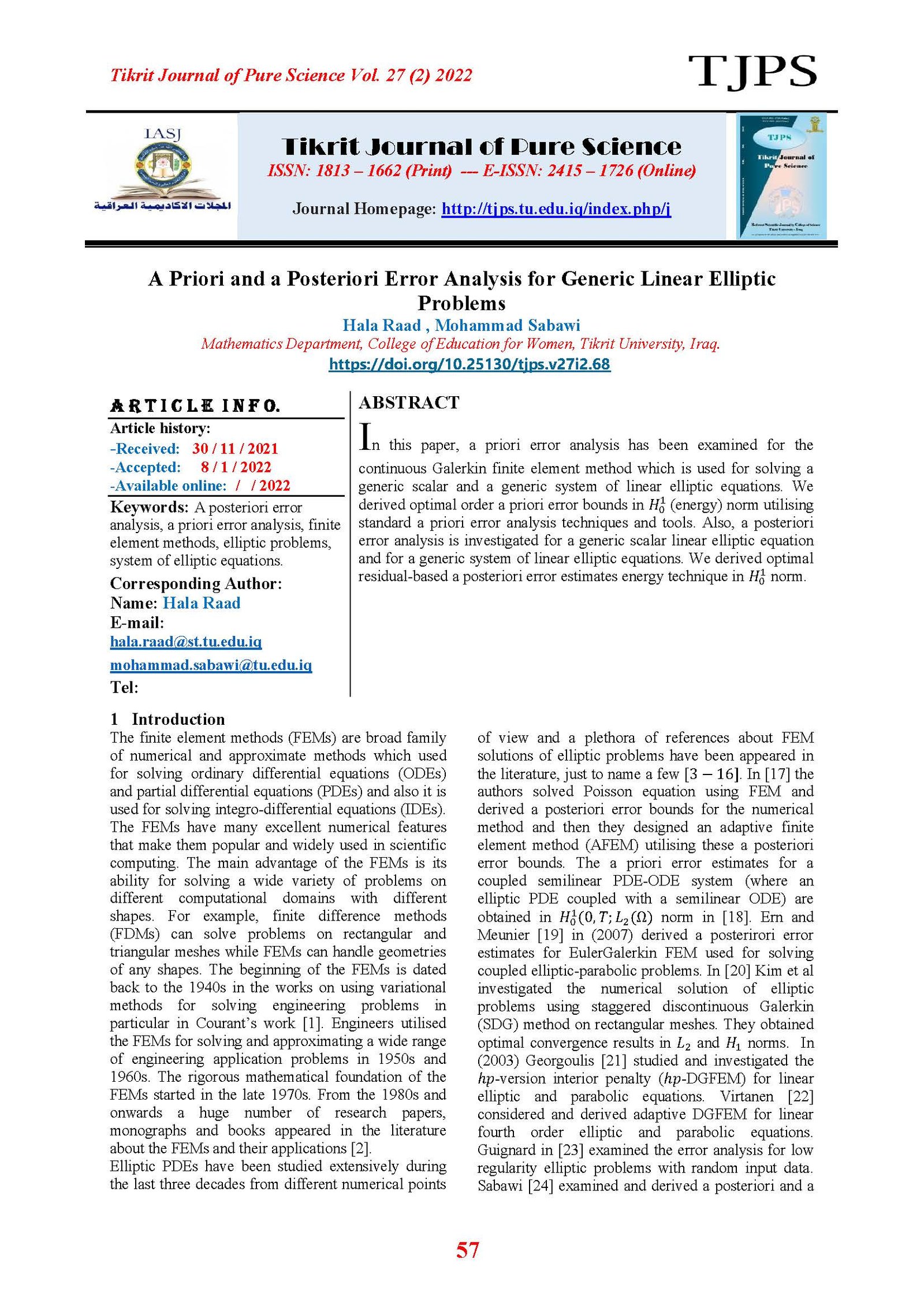A Priori and a Posteriori Error Analysis for Generic Linear Elliptic Problems
Main Article Content
Abstract
In this paper, a priori error analysis has been examined for the continuous Galerkin finite element method which is used for solving a generic scalar and a generic system of linear elliptic equations. We derived optimal order a priori error bounds in (energy) norm utilising standard a priori error analysis techniques and tools. Also, a posteriori error analysis is investigated for a generic scalar linear elliptic equation and for a generic system of linear elliptic equations. We derived optimal residual-based a posteriori error estimates energy technique in norm
Article Details

This work is licensed under a Creative Commons Attribution 4.0 International License.
Tikrit Journal of Pure Science is licensed under the Creative Commons Attribution 4.0 International License, which allows users to copy, create extracts, abstracts, and new works from the article, alter and revise the article, and make commercial use of the article (including reuse and/or resale of the article by commercial entities), provided the user gives appropriate credit (with a link to the formal publication through the relevant DOI), provides a link to the license, indicates if changes were made, and the licensor is not represented as endorsing the use made of the work. The authors hold the copyright for their published work on the Tikrit J. Pure Sci. website, while Tikrit J. Pure Sci. is responsible for appreciate citation of their work, which is released under CC-BY-4.0, enabling the unrestricted use, distribution, and reproduction of an article in any medium, provided that the original work is properly cited.
References
[1] Courant, R. (1943). Variational methods for the solution of problems equilibrium and vibrations, Bull. Amer. Math. Soc., 49, pp. 1–23.
[2] Zienkiewicz, O., Taylor, R. and Zhu, J. (2013). The Finite Element Method Its Basis & Fundamentals, Butterworth-Heinemann. The 7th edn.
[3] Ainsworth, M. and J. Oden, (2000). A Posteriori Error Estimation in Finite Element Analysis, Wiley– Interscience (John Wiley & Sons), New York.
[4] Amrein, M. (2015). Adaptive Newton methods for partial differential equations, Ph.D. thesis, University of Bern, Bern, Switzerland
[5] Amrein, M., Melenk, J. and Wihler, T. (2017). An hp–adaptive Newton–Galerkin finite element procedure for semilinear boundary value problems, Mathematical Methods in the Applied Sciences, 40(6), pp. 1973-1985.
[6] Amrein, M. and Wihler, T. (2015). Fully adaptive Newton-Galerkin methods for semilinear elliptic partial differential equations, SIAM J. Sci. Comput., 37, pp. A1637–A1657.
[7] Arnold, D., Brezzi, F., Cockburn, B. and Marini, L. (2002). Unified analysis of discontinuous Galerkin methods for elliptic problems, SIAM J. Numer. Anal., 39, pp. 1749–1779.
[8] Ciarlet, P. (2002). The Finite Element Method for Elliptic Problems, SIAM.
[9] Eriksson, K., Estep, D. Hansbo, P. and Johnson, C. Computational Differential Equations, Cambridge University Press, 1996.
[10] Gockenbach, M. (2013). Understanding and Implementing the Finite Element Method, Oxford University Press, Oxford.
[11] Langtangen, H. (2016). Solving nonlinear ODE and PDE problems, Lecture Notes, Center for Biomedical Computing, Simula Research Laboratory, University of Oslo.
[12] Larson, M. and Bengzon, F. (2013). The Finite Element Method: Theory, Implementation and Applications, Springer.
[13] Riviere, B. (2008). Discontinuous Galerkin Methods for Solving Elliptic and Parabolic Equations: Theory and Implementation, SIAM.
[14] Süli, E. (2000). Finite element methods for partial differential equations, Lecture Notes, University of Oxford.
[15] Verfürth, R. (2006). A posteriori error estimation techniques for finite element methods, Numerical Mathematics and Scientific Computation, Oxford University Press, Oxford,
[16] Georgoulis, E. (2010). Discontinuous Galerkin methods for linear problems: An introduction, Research Reports in mathematics, University of Leicester.
[17] Gokul, K. and Dulal, R. (2021). Adaptive finite element method for solving Poisson partial differential equation, Journal of Nepal Mathematical Society (JNMS), 4.
[18] Holtmannspötter, M. and Rösch, A. (2020). A priori error estimates for the space–time finite element approximation of a non–smooth optimal control problem governed by a coupled semilinear pde–ode system, arXiv:2004.05837v1.
[19] Ern A. and Meuier, S. (2007). A posteriori error analysis of Euler-Galerkin approximations to coupled elliptic– parabolic problems, ESIAM Math. Model. and Numer. Anal.
[20] Kim, H., Jung, C. and Nguyen, T. (2021). A staggered discontinuous Galerkin method for elliptic problems on rectangular grids, Computers and Mathematics with Applications, 99, pp. 133–154.
[21] Georgoulis, E. (2003). Discontinuous Galerkin methods on shape-regular and anisotropic meshes, Ph.D. thesis, Oxford University, Oxford, UK.
[22] Virtanen, J. (2010). Adaptive discontinuous Galerkin Methods for Fourth Order Problems, Ph.D. thesis, University of Leicester, Leicester, UK.
[23] Guignard, D. (2016). A Posteriori Error Estimation for Partial Differential Equations with Random Input Data, Ph.D. thesis, ÉCOLE POLYTECHNIQUE FÉDÉRALE DE LAUSANNE, France,
[24] Sabawi, Y. (2016). Adaptive Discontinuous Galerkin Methods for Interface Problems, Ph.D. thesis, University of Leicester, Leicester, UK.
[25] Cangiani, A., Georgoulis, E. and Sabawi, Y. (2018). Adaptive discontinuous Galerkin method for
elliptic interface problems, Math. Comput., 87, pp. 2675–2707.
[26] Cangiani, A., Georgoulis, E. and Sabawi, Y. (2020). Convergence of an adaptive discontinuous Galerkin method for elliptic interface problems, J. Comput. Appl. Math., 367.
[27] Dedner, A., Giesselmann, J., Pryer, T. and Ryan, J. (2019). Residual estimates for post–processing in elliptic problems, arXiv:1906.04658v1.
[28] Yang, J. (2020). The Error Estimation in Finite Element Methods for Elliptic Equations with Low Regularity, Ph.D. thesis, Purdue University, Indiana, USA.
[29] Ye. X. and Zhang, S. (2021). Low regularity error analysis for weak Galerkin finite element methods for second order elliptic problems, Numer. Math. Theor. Meth. Appl., 14, pp. 613–623.
[30] Casas, E. Mateos, M. and Rösch, A. (2021). Numerical approximation of control problems of non-monotone and non-coercive semilinear elliptic problems, Numerische Mathematik, https://doi.org/10.1007/s00211021-01222-7.
[31] Dios, B., Gudi, T. and Porwal, K. (2021). Pointwise a posteriori error analysis of a discontinuous Galerkin method for the elliptic obstacle problem, arXiv:2018.11611v1.
